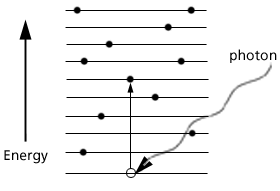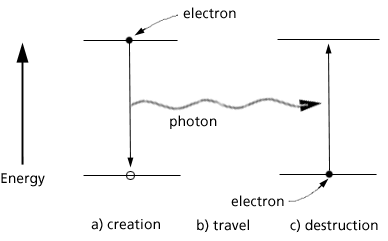The photon description
Basically, a photon may be termed as a quantum, a detached packet of light or an electromagnetic power. This implies that the photon occurs as an electromagnetic force carter, a different kind of electromagnetic radiation and a light quantum. The electromagnetic force effects can simply be observed under the macroscopic and atomic level since the photon is massless at rest.
In fact, the photon seems to be constantly moving and while in vacuities, each and every viewer can tell that it bears a constant velocity of light which is 2.998×108 meters per second. This readily lets in the long distance interactions. However, given that the photon appears like any other elementary particle, it is presently best described as a duality particle which exhibits both the properties of particles as well as waves (Griffiths 15).
The photon properties
From the theory of light, the photon:
- Have zero rest energy and mass
- Can have collisions or particle like interactions with other particles and electrons
- Can move in free space at a constant light speed of 2.998×108 m/s
- Can be created or destroyed when the emission or absorption of radiation occurs
- Carries momentum and energy that similarly relates to electromagnetic wavelength lambda and the frequency nu.
Lab experiments about the photon
Various laboratory experiments have been conducted to prove the viability of the above named photon properties. These are as subsequently discussed.
Experiments conducted on the mass of a photon
Photon is still perceived to be massless, and this has been subject to experimental investigations. Lab results show that if a photon particle has some mass, it will fail to travel at a similar velocity as light when in a free space. The speed will rely on its frequency yet it will be lower.
Since its relativity is not affected by this factor, the light velocity will not be the definite speed that the photon will move at. It will rather be a constant speed that an object can hypothetically reach as its maximum while in a free space (Grangier et al. 74). This means that it will not be the photons speed, but the space time velocity for gravitons and gravitational waves.
Under Coulombs law, the effects of a massive photon are made apparent. The electromagnetic fields are seen to have some degrees of freedom with the modification of this law. The tentative lab review indicated that the quantity of a photon produces very complex upshots in comparison to the reliance on the light velocity frequency.
Thus, if this law is held invalid, the subjection of a photon to external electric fields would cause some electric field to be present within the hollow-conductor. This means that there is some accuracy that a photon bears no mass this law (Dehlinger and Mitchell 903). Finally, in a galactic vector potential experiment, it was observed that when a photon has no mass, magnetic field will be observed and the reverse also holds.
The particle-wave duality
Just like any other quantum element, the photon tends to display the characteristic of both particles and waves. It is very hard to visualize the particle-wave dualistic nature. However, laboratory experiments confirm that the photon noticeably shows waves-like occurrences namely interfering as well as diversion on its wavelength measures.
For instance, in an experimental illustration, there was a real slit that was ran across, and one photon which passed through that double slit experiment landed on the used screen and exhibited the interference incidence (Hardy 1666). Founded on Maxwell photon function, such an occurrence is dubbed as chance distribution.
The laboratory experiment nonetheless verified that the photons barely fragment or divide when they are meeting ray-splitters. Moreover, they hardly sprawl as they propagate since they are not tiny electromagnetic energy beats. Most experiments indicate that photons are more similar to the point like particles.
From these experiments, the assertions are that the photons are emitted and absorbed in totality by very lesser systems as compared with their wavelengths and these include the point like electrons or even the atomic nucleus which approximately measures 10-15 metres across.
Einstein and other scientist conceived that photons are point like units whose paths become formed by chance. Current lab experiments have shown that this is not the case and the proposition was disproved by the lab experiments known as the photon correlation experiment (Hardy 1667). The experiments showed that the photons produce the electromagnetic fields by themselves that sequentially stem from the quantum field theoretical laws and the local gauge symmetry.
Furthermore, as photons pass via the double slit experiments, corresponding interference patterns are likely to be generated by both the material particles along with the photons. With respect to the measurable atoms, such an incidence takes place due to Schrodinger wave-function. In contrast, Maxwell light-wave interfering is assumed to be the basis in relation to the photons.
However, physicists have disagreed with the assumption that both Schrodinger and Maxwell equations for the proton are similar. Mathematically, lab experiments have disproved this postulation by showing that they are totally different because the probability wave function by Schrodinger merely explains the complex fields whilst the equation formed by Maxwell explains issues encountered in the real field.
Schrodinger equation is hence not applicable to the photons. Since photons have no masses, their localization cannot happen without any destruction (Kwiat and Hardy 34). The lab experiment nullification of the Heisenberg normal uncertainty principle which was linked to photons implies that it is only the second quantum photons theory that is generally accepted by physicists.
The life cycle of the photon
All photons normally behave in a similar way. In vacuums, photons tend to travel at a similar velocity with other forms of energies. Light which is defined as photons permits the disappearance as well as the absorption of light that is to be visualized. On metal surfaces, when an incident of the photons occurs, all energies will be transferred to the electrons and the photon will disappear (Hardy 1666). The electron which has the photon charges will then depart the metallic cover. This is illustrated in the diagram 1 below.

In diagram 1, all the energies are transferred to electrons by the photon incident that takes place on the metal surface within a free space. In fact, photoelectric effect occurs if an electron that has the photon energy tries to leave the metal surface but becomes detected.
At exceptional high powers, photons could produce electrons. At this point, positrons (anti particles of an electron which is definitely indicted with matching electron mass) in addition to electrons are formed at great resultant powers. The gamma-ray similarly dubbed as great electrical powers vanishes when positrons in addition electrons are made in the brace making. See diagram 2 below.

The electron anti-particles along with the electrons which are reversely indicted particles mutually reunite then vanish when the photon is formed. When visible light is available, the created photons become engrossed and then vanish as they give their energy to the furthest atomic electrons which seem to be seized in position by little electron voltage energy. Diagram 3 below exhibits an eventual photon that loses its energies and disappears through transferring electrons to upper energy levels.

The path taken by light is always reversible under bending and mirror image. An identical reversibility is usually found when electron and photons interacts. In diagram 3 above, when the energetic electron goes back to the initial place, the energy transferred during the shift from higher energy states to lower states materializes in form of the photon.
In pair production, similar reversibility is also apparent (Hardy 1667). The entire processes are what give rise to the photon life cycle which is represented by the creation and disappearance of photons and electrons.
Basically, the photon life-cycle is soundly expounded on by photons as well as electrons interfaces as revealed in chart 4 below.

In this diagram, the electron life cycle shows that when an electron loses energy at point ‘a’, it leads to the creation of the photon. This photon at point ‘b’ travels within the available space and encounters the electron at point ‘c’ then it vanishes.
Conclusion
Even though the photon is massless, it appears as a simple atom or particle. Laboratory experiments have shown that the photon might not decay by itself even when its energy is produced and transmitted as the photon interacts with another particle. Further, experiments have shown that the photon appears to be electrically neutral and bear particles which are similar to the anti-photons.
Works Cited
Dehlinger, David and Wilson Mitchell. “Entangled photons, non-locality, and Bell inequalities in the undergraduate laboratory.” American Journal of Physics 70 (2002): 903-910. Print.
Grangier, Peter, Greg Roger and Andrea Aspect. “Experimental evidence for a photon anti-correlation effect on a beam splitter: A new light on single-photon interferences.” Euro physics Letter 1 (1986): 173-179. Print.
Griffiths, David. Introduction to Elementary Particles, Weinheim, Germany: Wiley-VCH, 2008. Print.
Hardy, Larry. ‘‘No locality for two particles without inequalities for almost all entangled states.’’ Phys. Rev. Lett. 71.2(1993): 1665–1668. Print.
Kwiat, Paul and Larry Hardy. “The mystery of the quantum cakes.” American Journal of Physics 68 (2000): 33-36. Print.